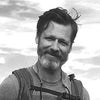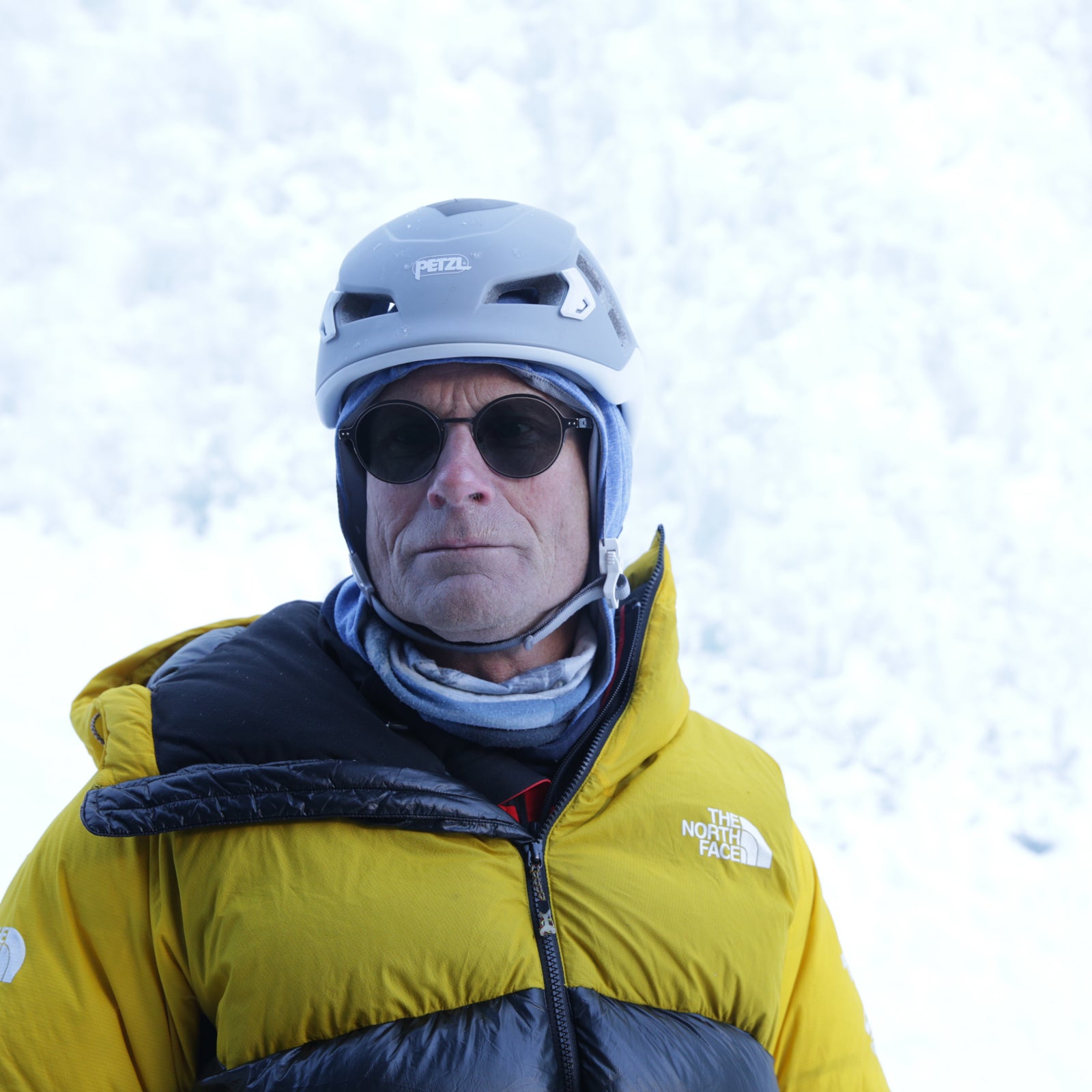When Conrad Anker gives you ice-climbing advice, you listen. We’re in Hyalite Canyon, outside of Bozeman, Montana, one of the premier��ice-climbing destinations in the country, and he’s guiding me on one of the many routes scattered over a few miles of cliff. But even as I struggle to maintain��my strength through a 60-foot-tall, mildly overhanging single-pitch ice climb, these routes are child’s play for Anker, the 56-year-old who became the face of mountaineering after��discovering George Mallory’s body on Mount Everest in 1999. Since��then, he’s climbed the world’s tallest peak three times,��taken part in��countless National Geographic��expeditions, and was the subject of a 2015 feature film��by his climbing partner, Jimmy Chin, about their summit of Meru.��
There’s also the massive list of big-mountain climbing routes he’s put up in Patagonia, the Himalayas, Alaska, Antarctica, Yosemite, and Canada. “Establishing new routes is my publicly accepted stab at graffiti��and immortality,” he says. “I recognize the ego in that, but it’s true.”
Anker was sponsored by the North Face at 21��and showed no signs of slowing down in the years after. But��in 2016, at the age of 54, he had ��while attempting to summit Lunag Ri, the tallest unclimbed mountain in Nepal. It hit, sudden and painful, as he was moving up a mixed-ice route behind the lead climber. After it passed, though, he still��had to rappel down and hike out to advanced base camp with a numb lip and aching left arm before being helicoptered out to a hospital in Kathmandu for surgery.
This heart attack��had Anker reassessing his work and life. Before nearly dying on Lunag Ri, Anker��had a superhuman ability for staying healthy—his worst injuries during more than three decades of climbing��were��a dislocated thumb and an infected��tick bite. “I’d get a cold every 18 months. That’s about it,” he��says.��
After Lunag Ri, Anker heeded his doctor’s advice and moved away from expedition climbing. Last year��he stepped down as captain of the North Face’s expedition��team after 26 years in the role; the title is now held by ski mountaineer��Hilaree Nelson. Anker also limits his time at high elevation; he was supposed to manage a trip to the Himalayas in April��but eventually turned it down. Basically, Anker has been ordered to take it easy—a tricky task for one of the��most famous mountain climbers in the world. “I’m like a dog who doesn’t know better,” he says while we take a break from the wall at Hyalite Canyon. “I’m always amped. Total ADHD. But the heart is the one muscle that can’t fail. So, it’s about realizing where you are in life and knowing your limits.”
Before nearly dying on Lunag Ri, Anker had a superhuman ability for staying healthy—his worst injuries during more than three decades of climbing��were��a dislocated thumb and an infected��tick bite.
But it’s hard to pin down��Anker’s limits. On the afternoon in Hyalite Canyon, he spends most of his time��belaying and helping several climbers who won the chance to hang with Anker through his new sponsor, Dove Men+Care. But at some point, he gets antsy and starts traversing along the bottom of the wall, lightly tapping the axes into the ice and gently poking his crampons for purchase. Eventually, he ropes in and starts climbing routes, sending them gracefully��with only one ax.
I watch him��work his way up the toughest route on the wall. It took every ounce of strength I had to send it a few minutes earlier, but Anker looks weightless, like the feat takes��no effort at all. When asked how people can learn to climb like him, Anker smiles. “I managed a nordic center in Utah in the eighties,��and we had European��skiers training at the center quite a bit,” he says. “They could tell if a skier was American just by seeing them ski, because American skiers are always breathing heavy. They aren’t working efficiently.”��The key to climbing, Anker tells me, whether it’s Everest or Hyalite Canyon, is efficiency of movement,��only moving as much as you have to.
Instead of swinging axes into the ice or kicking his toes into the wall, Anker sets the tip of his axes on tiny ledges and slowly and carefully places his crampons into crevices. Rather than big and dramatic movements, his are small and effortless. “Everest is basically hiking up a ski slope,” Anker says. “But with a 2,000-pound elephant on your chest and head. You can’t waste any motions. You have to orient your body for max efficiency.”
This climbing efficiently comes from knowing the medium inside and out, according to Anker. “I know I can climb this route with just one ax, without much effort, because I’ve climbed it without ropes half a dozen times this season alone. I know exactly what it takes,” he��says. Developing that kind of familiarity begins at the climbing gym. He and his family have a lifetime membership to one in Bozeman, where he continues to train a few nights a week. “That’s where I go to relax, and they’re great spaces to get in that repetition you need to start climbing efficiently. It’s where you start learning the balance you need to keep from having to work so hard on the wall,” he says. ��
“Everest is basically hiking up a ski slope,” Anker��says. “But with a 2,000-pound elephant on your chest and head.”
Balance and efficiency. I expect Anker to go into a philosophical tangent about mindfulness, because it seems like the next logical step, but he shrugs off��the concept. “Sometimes I’ll try to count to 20, but that’s about it. I should probably get better at that stuff,” he says. “I guess I do it in the climbing gym. Focus, breathing, that sort of thing.”
Later that afternoon, while drinking beers in his office, Anker talks about the next phase of��his life, now that he’s not leading expeditions to the world’s toughest peaks. As vice president of the , a training ground for Sherpas and climbers at the base of Everest, he’s looking forward to��the grand opening of the new headquarters in June. He might write a book. He��hopes to serve as a mentor for the next generation of climbers. But mostly, he wants to make sure his climbing career serves some greater purpose.
“I want to be the eyes and ears of the mountains now,” says Anker, who’s an outspoken member of��, a nonprofit advocating for��climate protections.��“The change I’ve seen in the mountains is huge. The Khumbu��Icefall on Everest [a glacier near Base Camp] doesn’t look like it did 20 years ago.��The diminishing snowpack and melting ice tell you exactly what’s going on in the world.”
When I ask him if there’s anything he feels like he’s left on the table in terms of mountain climbing,��he doesn’t seem��worried. “I have plenty of ‘no successes’ I could look back on, but I don’t want to live life in reverse. And I might not be leading expeditions anymore, but I’m still climbing. I’m still outside,” he says. “I might be on the injured reserves, but I’m having as much fun as anyone.”


